Pavé Diamond Rings Setting: What to Know Before Purchase
Pros and Cons of Pavé Settings
Pros and Cons of Pavé Settings
A pavé setting in an engagement ring features small diamonds lining the shank, creating an illusion of continuous sparkle. To achieve this, a jeweler drills holes into the band, placing each diamond into them. These diamonds are then secured using tiny beads or mini-prongs, resulting in a seamless line of brilliance.
There are several types of pavé settings including:
If you believe that every facet (pun intended) of your engagement ring should be optimized for sparkle, consider pairing your diamond with a pavé setting. The pavé setting adds a level of fire and brilliance that will complement the radiance from your center diamond. The two combine for potent punch of romance and statement. We will start out with our favorite picks for pavé settings then do a deep dive into the intricacies of pavé settings.
What is a pavé engagement ring setting?
Why choose a pavé engagement ring?
What are the different types of pavé settings?
Pros and cons of pavé settings
Pavé settings vs. other styles
Where to buy a pavé setting engagement ring?
FAQs about pavé style settings
Bottom line recommendations
Why you should trust us
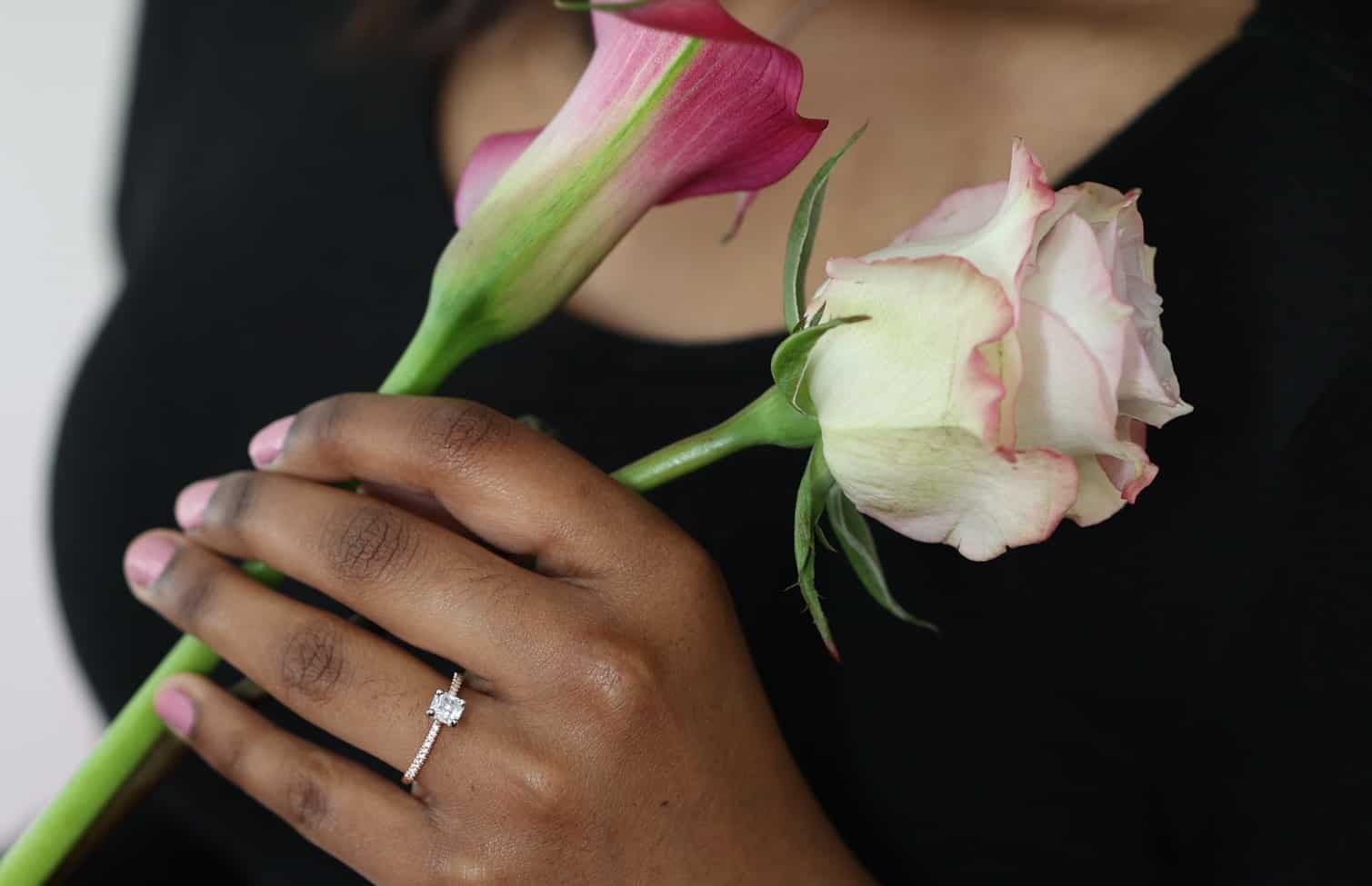
A pavé setting is a type of engagement ring setting in which the shank of the ring is lined with small diamonds. These pavé set diamonds are held in place with metal prongs or beads, creating the appearance of a line of continuous small diamonds.
Pronounced “pa-vay,” pavé originates from the French word “to pave” — in this case, as in paved with diamonds. In a pavé setting, small diamonds line the band. The metal prongs or beads that hold the diamonds in place are barely visible.
Pavé settings appeal to everyone. If you ever look at the top ten popular rings on an engagement ring site, pavé settings will be featured prominently.
The pavé setting adds extra sparkle to an engagement, all while emphasizing the beauty of the center diamond. Pavé settings are available in a wide range of styles, from modern settings to a range of vintage designs that incorporate pavé-set diamonds.
Diamonds are “pavé set diamonds” when they’re as small as .01-.02 carats. Diamonds smaller than that are considered “micro-pavé set diamonds” (which are usually set in thin bands).
A jeweler typically drills holes into the band and carefully places the small diamonds into the holes. Tiny beads or mini-prongs are formed around each diamond to secure them in place. With a pavé ring, the effect is one of continuous sparkle.
This petite pavé setting is the perfect mix of style and tradition. The thin band introduces a level of delicacy to the design, while the sparkle from the pavé adds a nice flourish. This style works with every diamond shape. You can make it a bit more traditional by going with a yellow gold version.
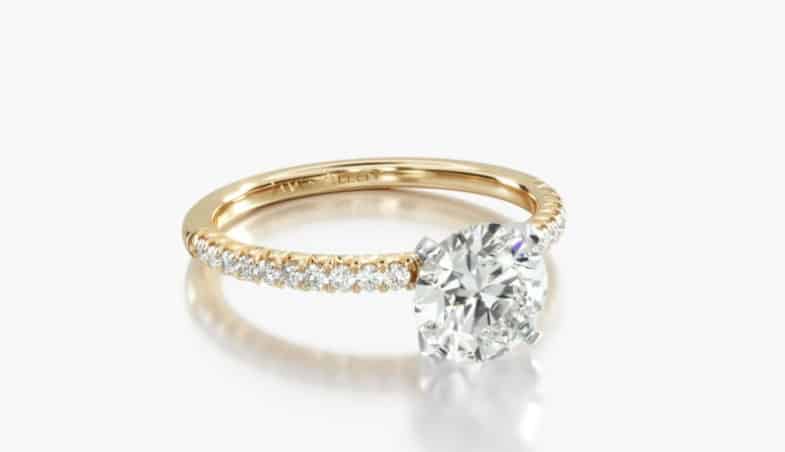
Another can’t-miss choice is the French cut pavé diamond ring. The French cut adds an interesting texture by adding a bit of separation between each of the small diamonds. My personal favorite is this setting in rose gold.
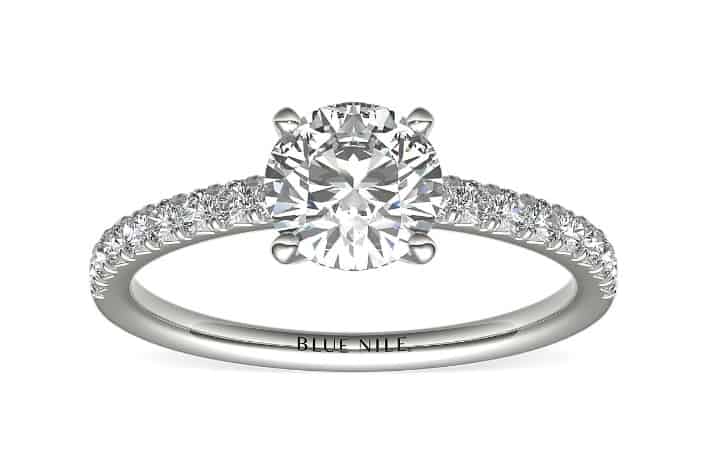
If you are looking to add some sparkle around your center diamond, but want it to be fashion forward, we suggest this crossover double twist pavé setting. While the center stone is still the main event, people will do a double take to get all the unique details on this setting.
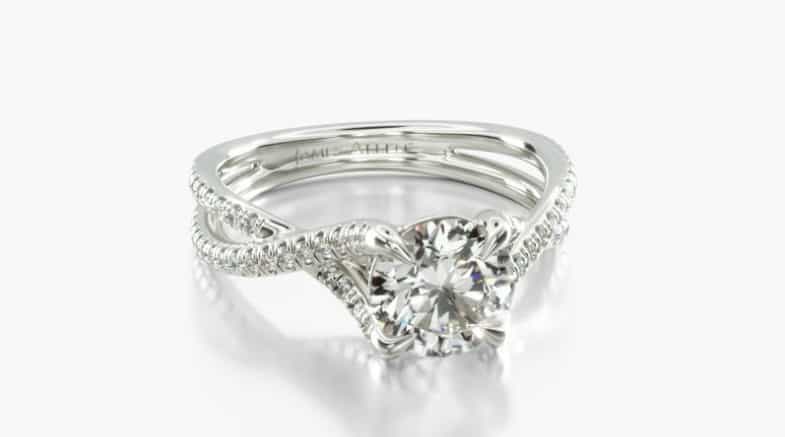
If you prefer tradition over the latest trend, tapered baguettes are the way to go. This classic style will fit with round and cushion cut center diamonds but really shines if you are going with square or rectangular diamonds like emerald or princess.
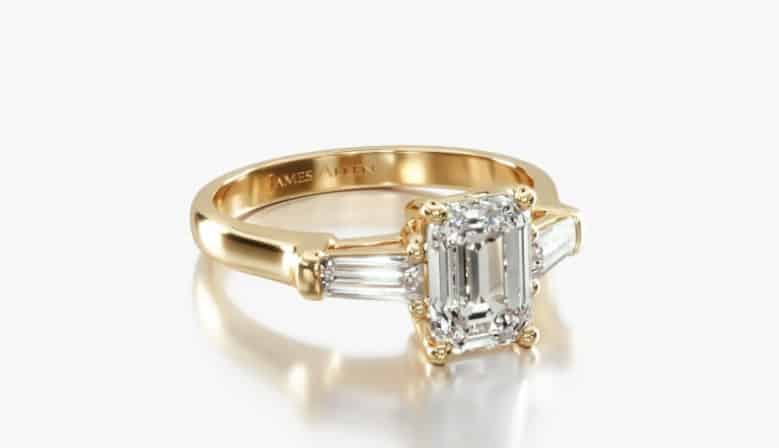
A pavé setting is a stunning choice for someone with an elegant, timeless style. The intricate detail of the additional diamonds adds depth and grandeur to the ring.
Opting for a pavé setting ensures you have extra personality, without distracting from the center diamond. The best part of a pavé ring? It pairs well with other types of settings, like solitaires, halos and three-stone rings. No matter the style you want, you can almost always add pavé detailing.
For example, look at Simone Biles’ new engagement ring. It’s a stunning pavé ring setting (probably three-sided) with a gorgeous oval cut in the center. Or this halo ring with a beautiful pavé detail Wolfgang Van Halen got for his longtime girlfriend.
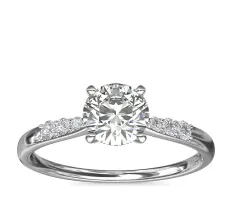
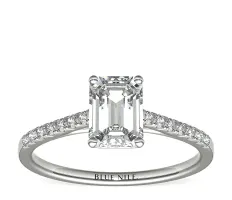
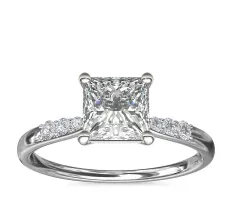
There are several different types of pavé settings used for engagement rings today, including the French pavé, petite pavé and several others. Below, we’ve listed the most common pavé setting types, as well as their unique design features:
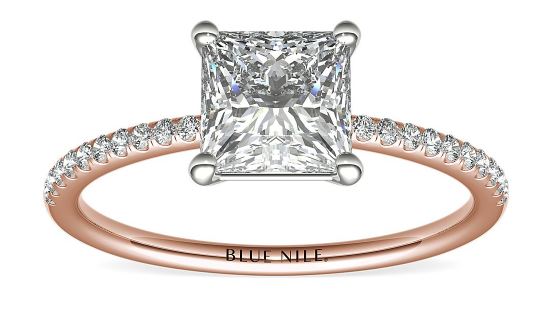
Micro pavé settings use incredibly small diamonds with a carat weight of less than 0.01ct per stone. A typical micro pavé setting may contain more than 100 of these diamonds set close to one another to create the appearance of a continuous band of diamonds.
For example, a trio micro pavé engagement ring features about 128 diamonds with a total carat weight of 0.78ctw, meaning each diamond an average carat weight of barely 0.006ct.
Because micro pavé settings contain so many diamonds, they often have a beautiful sparkle that continues along the shank of the ring. Our full guide to micro pavé rings goes into more detail about what you should know if you’re considering this type of pavé setting.
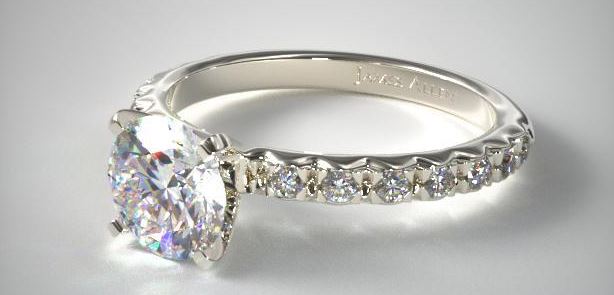
French pavé settings differ from classic pavé settings in that each diamond is set inside a tiny v-shaped space cut into the ring. This cut makes the sides of each diamond more visible, with less visible metal and the appearance of a line of continuous diamonds.
For example, a French pavé diamond engagement ring from Blue Nile uses 1/4ctw of pavé set diamonds. If you view the ring from the side, you can see the v-shaped cuts made into the ring to accommodate the pavé-set diamonds.
Like other pavé settings, the French pavé setting creates a gorgeous sparkle, with less visible metal between each small diamond.
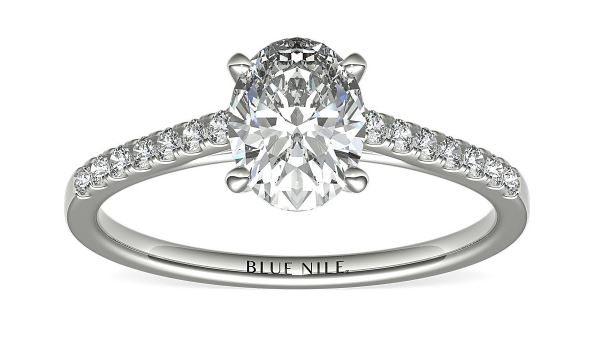
Petite pavé settings are similar to traditional pavé settings. However, instead of using the large prongs used for a classic pavé setting, a petite pavé setting uses smaller prongs that allow for the pavé diamonds to be more visible. The smaller prongs holding each diamond in place make the pavé diamonds easy to see, creating a great sparkle that continues along the shank of the ring.
When choosing a setting design, consider the style of the wearer but also the level of maintenance required. Review the pros and cons of a pavé setting before making a final decision.
We recommend determining his or her ring size early in the design process to prevent resizing issues.
Pavé settings are often compared with channel settings, prong settings and other engagement ring settings that feature small diamonds. We’ve listed four of the most common settings below and explained how they differ from the classic pavé setting.
Pavé is a general term used to refer to any type of setting with pavé-set diamonds. Micropavé refers specifically to very small diamonds (typically less than 0.01 carat) that are uniform in size and set using very small prongs.
Pavé and channel settings have several key differences. In a pavé setting, the small diamonds line the band and are held in place using small prongs. In a channel setting, a small channel is cut into the ring, with diamonds set in a row inside the channel.
Pavé and shared prong settings look similar at first glance, but use a slightly different design to hold their small diamonds in place.
Pavé and French pavé settings have a slight difference in design, with the French pavé setting featuring a V-shaped cut under each diamond to increase the visibility of the stone.
Identifying the style of your engagement ring is important, but so is choosing where you’ll purchase your ring. In order to get the best value for your budget, be selective and choose a highly reputable vendor. After all, jewelry vendors are not created equal.
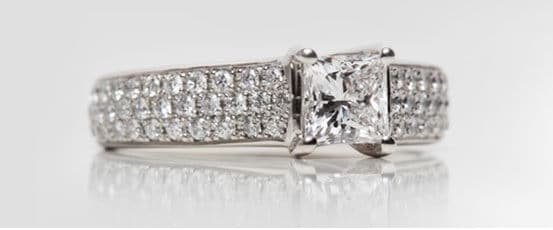
Throughout over 20 years of experience, we’ve closely vetted diamond sellers. We have a consistent pulse on the best and most reliable companies in the business.
The diamond dealers below are highly reputable. They offer extensive collections of both beautiful diamonds and settings. All diamonds come with a GIA or AGS certificate—allowing you to trust what they’re selling you.
Blue Nile maintains the largest online inventory of diamonds and settings. No matter your style, you’ll have a superb selection to choose from. Blue Nile is known for their remarkable diamonds and high-quality jewelry settings.
We recommend James Allen because of their appealing prices, high-quality jewelry and incredible diamond imagery. You can view each diamond closely with photography before making a purchase. They’re known for their excellent customer service and return policies.
Brian Gavin is an excellent choice if you’re looking for a diamond that’s cut incredibly well. Select a diamond from the “Brian Gavin Signature” Hearts & Arrows collection for an exceptional stone.
Leibish is our preferred vendor for gemstone engagement rings and jewelry. A colored gemstone, like an emerald or sapphire, is a unique, lower-cost alternative to a diamond. In addition, Leibish & Co. maintains a large collection of fancy color diamonds like purple diamonds and canary yellow diamonds.
If you have any questions about these vendors, don’t hesitate to contact us.
Yes. The diamonds used in pavé and micro pavé settings are real diamonds, although they tend to be very small. It’s common for pavé rings to use diamonds that are 1 to 2mm in diameter, with micro pavé settings using even smaller diamonds in the 0.01 carat range.
Because of their design, pavé rings are very difficult to resize. Making any significant changes to the ring’s size can damage the small prongs that hold the pavé diamonds in place. If the prongs are significantly weakened, it’s possible for the small pavé diamonds to fall out of place.
If the pavé diamonds are only set in a part of the ring, it’s sometimes possible for a skilled jeweler to make small adjustments to the ring’s size, such as making it a half size larger or smaller.
Because pavé rings are so difficult to resize, it’s important to know your fiancé-to-be’s ring size if you’re considering a pavé ring. Our ring size guide includes several techniques that you can use to work out your partner’s ring size and avoid the need to resize your ring after you propose.
Pavé settings will usually cost more than a solitaire setting. However considering the extra level of sparkle pave settings add to your engagement ring, it is a small investment with a sizeable return.
Want the most stunning ring for your budget?
Review our other Diamond Pro resources for tips on selecting the perfect ring for the one you love.
Shop for pavé diamond engagement rings here.
A pavé engagement ring is a gorgeous option for many styles and personalities. The small diamonds that line the band offer extra sparkle and elegance. Pavé designs include stunning round cuts in halo settings and oval diamonds set with a pavé band. Review our guide below to understand the pros and cons of a pavé setting, and see if it’s the right choice for the one you love.
Most importantly, shop for an engagement ring at a reputable diamond vendor. We suggest the James Allen, Blue Nile and Brian Gavin Diamond collections to get the best value and quality.
Questions? Send our diamond consultants an email.
Interested in a different setting style? Review all common styles in our summary setting article.




Before you buy a diamond, get personal buying advice from industry veterans. We'll help you get the best diamond for the money.
DISCLAIMER: We don't use your email for marketing. Period.
A diamonds’ price is determined primarily by the 4 Cs of the diamond. On the wholesale level, diamond prices are first based on a diamond shape and
Buying an engagement ring is often one of the first major purchases in a person's life. The process can be fraught with tension as there are so m
A wide range of 1 carat diamonds exist both in online markets and local diamond jewelry stores. Not only are there significant differences in beauty
Please enter your email address to receive your 25% off coupon code:
Here is your coupon code: GFDSF3GF